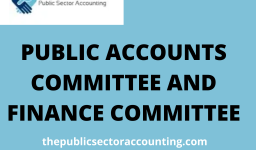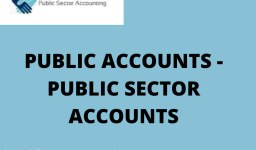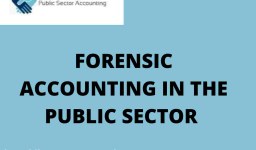In session two, the key finance officers and institutions in Government were identified and discussed along with their financial responsibilities and functions. In this session, the various sources of Government revenue and expenditure will be identified.
We will also discuss revenue and expenditure recognition in the public sector, referring to the relevant IPSASs.
Objectives at the end of this session, you should be able to:
- a) Identify the sources and classifications of Government revenue
- b) Identify the sources and classifications of Government expenditure
- c) Recognize revenue and expenditure in the public sector.
Now read on…
Summary of Contents
Government Revenues
The government has the constitutional responsibility to provide essential services to its citizenry and all these require a huge amount of resources to discharge. The government needs money to provide public goods and services such as schools, roads, security; pay compensation to public sector employees; service debts; reduce poverty through social benefits; provide grants and subsidies for consumption among others.
In order to carry out its work, the government must have funds to finance them. This will be possible by ensuring that it has adequate and sufficient funds in the consolidated fund.
To ensure the adequacy and sufficiency of funds, it has to have a good financial system to generate enough revenue. Government revenues are monies raised or received by the government or on its behalf arising from its principal business.
Sources of Central Government Revenues
Government revenue can be examined from different levels:
- a) Central Government (consolidated fund)
- b) MDAs (to meet commitments)
- c) Subvented Entities
- d) MMDAs
- e) State-Owned Enterprises for the purpose of our studies, we will concentrate on the central government sources of revenue paid into the consolidated fund.
The main sources of revenues to the central government (consolidated fund) include Tax Revenues, Non-Tax Revenues and Grant.
- Tax Revenue Taxes are compulsory levy imposed on the people of a country by a legitimate body or person. Tax revenue is basically the revenue the government raises through taxation. In Ghana, only Parliament can approve the imposition of taxes on the people of Ghana (Article 174 of the Constitution).
Taxes can be grouped into Direct taxes or Indirect taxes
- Direct Taxes A direct tax is referred to as a tax levied on person’ income and wealth paid directly to the government.
The tax burden associated with these taxes falls on the taxpayer. It is progressive in nature, that is, it increases with an increase in income or wealth. Examples of direct taxes include:
- Personal income tax (PAYE)
- Corporate taxes
- Rent tax
- Vehicle income tax (VIT)
- Capital gain tax
- Stamp taxes
- Dividend taxes
- Indirect Taxes These are taxes imposed on goods and services. The burden of the tax falls on the final consumer who consumes the goods and services.
Examples of indirect taxes include:
- Excise duties (imposed on domestic goods such as beer, polythene bags, sachet water etc)
- Value-Added Taxes (imposed on chargeable goods and services)
- Communication service taxes (paid on air time)
- Custom duties (export and import taxes)
- Petroleum taxes on petroleum products and operations. b) Non-Tax Revenue This refers to other sources of government revenue apart from taxation. Collection of non-tax revenue is the responsibility of the various agencies or institutions involved in such transactions or services.
Non-tax revenues include:
- Receipt from the sale of public assets
- User fees and charges for services such as passport fees, academic facility user fees, DVLA charges, etc
- Interest, dividend, royalties and profit from government direct investment.
- Royalties on natural resources (mining companies) etc
- Rent income
- Sale of goods such as gold, cocoa etc. c) Grants These are financial assistance received freely by a government from either bilateral or multilateral sources without any requirement of repayment to support its operations
. Bilateral grants are those grants received from other governments whereas multilateral grants are received from international agencies such as International Monetary Fund (IMF), World Bank etc. Grants are usually in the form of money though some types of grants may offer access to resources, services, goods or other aid. Grants are often given to fund a specific project and require some level of compliance and reporting.
Government Expenditure
Government expenditure comprises all expenses incurred by the central government, the local government and other public sector entities for the delivery of public services.
Government expenditure can be classified into statutory and discretional expenditure.
Statutory Expenditure
These are expenditures charged on the consolidated fund by the constitution or by an Act of Parliament. They are regarded as statutory obligations and therefore do not require prior approval of parliament.
Examples of statutory expenses are debt servicing, pension payments, emoluments of certain public officers such as the Auditor General, transfers to statutory funds such as District Assembly common fund, Social security contribution (13%) etc.
Discretionary expenditure
These are expenditures that require parliamentary approval before an authorization is given. They are also known as a non-statutory expenditure.
The government has control over the decision to incur such expenditures.
Government of Ghana expenditure classification has been revolving over time. According to the chart of accounts (a created list of the accounts used by an organization to define each class of items for which money or the equivalent is spent or received) expenditure can be classified as follows:
- a) Medium Term Expenditure Framework (MTEF) Classification (1999 – 2011): Under the MTEF, discretional expenditure was classified into Personal emolument: compensation to employees of government
- Administration cost: cost of running government establishment to provide public services
- Service cost: cost incurred in providing general public services and/or improving the capacity of entities to deliver more efficient service iv. Investment cost: expenses on the construction or acquisition of capital assets b) Ghana Integrated Financial Management Information System (GIFMIS) Classification (2012 to date):
- This is the current system of expenditure classification in Ghana with the prime objective to improve the effectiveness of service delivery and the allocation of scarce resources.
Under GIFMIS expenditures are put into eight categories as follows:
- Compensation for employees: this is made up personal emolument and all allowances payable to employees
- Goods and services: this is a combination of the administration cost and service cost as outlined in MTEF item ii and
- Consumption of fixed capital: it measures the portion of non-financial assets consumed within an accounting period. An example is the depreciation of non-current assets.
- Public interest: this is made up of interest on domestic debts and external debt
- Subsidies: this refers to all subsidies to both private sector and public sector
- Grants: this refers to government assistance to other countries or the local government.
- Social benefits: these are expenses on social security, such as national health insurance, school feeding etc.
- Other expenditures: this includes contingent expenses and other expenses which do not fall under any of the 7 groups above. Self-Assessment Questions Exercise
- List three (3) main sources of revenue to the central government.
- Differentiate between Statutory and Discretionary Expenditure.
- Explain five (5) of the expenditure categories under GIFMIS





Leave a comment